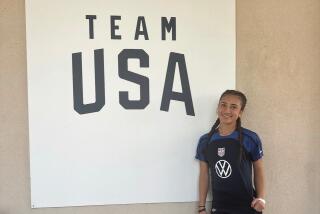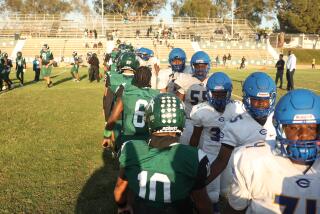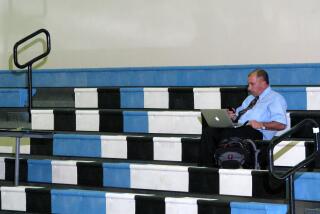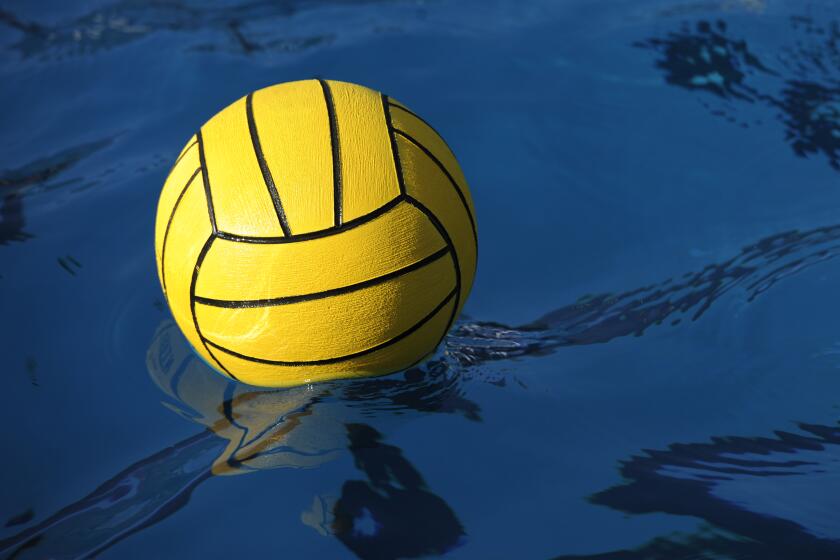Being a Wizard on the Blacktop Means Nothing Around Here : Basketball: What do high school coaches look for in a player? It all begins with a rigorous combination of instruction and drills known as tryouts.
A teen-ager takes his place in the layup line. He anxiously awaits his turn, hoping that in some way his performance that day will give Crenshaw Coach Willie West reason to bring him back for another shot at a coveted position on one of the country’s most successful high school basketball programs.
The nervous youngster is one of more than 1,000 kids in the Central City who, for a three-week period in October and November, go through a rigorous combination of drills and instruction known as tryouts.
After the three-hour workout, the teen-ager joins the rest of the group, which has formed a circle around West as if he were telling campfire stories.
But West’s intention is not to entertain. Instead, he informs the young hopefuls of the standards they must meet if they expect to become members of the Cougars basketball team.
“On Dec. 8, Santa Ana Valley comes to the Cougars’ Den,” said West, referring to Crenshaw’s first home game, the start of the school’s drive for a third straight state championship and 14th City Section 4-A Division title.
“I have lost four games in this gym,” said West, who began coaching at Crenshaw in 1971. “That means when you step onto this floor, you should be ready to play hard, smart and give 110%.”
Senior Ronnie Arch knows that Crenshaw tryouts can be a crucible for newcomers, who are not used to the fierce competition.
“It was hard and very competitive; I felt like a little kid getting pushed around,” said the 6-6 Arch, who first tried out for the varsity as a sophomore.
“You just have to take one practice at a time and play hard. It’s easier this year because I’m used to it.”
Arch and teammate Raymond Palmer vied for a roster spot against the likes of Tremaine Fowlkes, Kris Johnson, Reggie McFerren and Tommie Davis--all of whom received Division I scholarships last season.
With that kind of opposition, Palmer said, the only way to make it is to stay focused.
“It was hard (for me) because there were people bigger than me,” said Palmer, a 6-7 forward. But “I worked hard and just played my game. If you really want it, you can have it.”
Getting it is up to the coaches, who must weigh several factors when determining whether a player fits into the team’s scheme.
One of the most important is youth.
“I look at the younger kids because I predicate everything on the youth,” Dorsey Coach Kevin Gibson said.
“I will pick an 11th-grader before a 12th-grader. I try to get three or four 10th-graders who can contribute during the season. (That way) they get experience and an understanding of what I want over the next two years.”
Like Gibson, Coach Randolph Simpson of Manual Arts also puts a premium on youth.
“I go to the younger kids because they will be there longer,” said Simpson, whose Toilers have made the playoffs each of his seven years as coach. “The longevity factor is very important.”
Of course, every coach looks for a player with tremendous athletic ability or a deft shooting touch.
But as Roosevelt Coach Dave Perea has found out, there are other intangibles that make for a great player.
In the Roosevelt area, the smaller players are usually the better players, which means Perea must find athletes with qualities that compensate for a lack of size.
“To compete with athletically superior schools like Crenshaw and Manual Arts, I look for smart kids, scrappiness and heart,” said Perea, whose Roughrider team lost to Banning in last year’s City 3-A championship game.
“In all my years at Roosevelt, the most common comment made to me (about the team) is that we play hard. We might get outmuscled, but not outhustled.”
Just as important as who a coach decides to keep is who he chooses to cut. The process of elimination can backfire if a coach acts in haste.
“The first cuts are not hard to make because running, jumping, hand-eye coordination, playmaking and shooting are readily apparent,” Perea said. “When you get down further, it gets harder.
“So much of coaching is projecting. Mario (Hernandez) came to my door the last week of tryouts and said he wanted to play. I discouraged him, but he came out, made the team and turned out to be my best player.”
Tryouts begin with conditioning drills, perhaps the most important phase in terms of allowing a coach to survey a player’s physical ability as well as his spirit and desire.
“The first couple of weeks, kids cut themselves through conditioning because they don’t have the desire,” Gibson said.
Perea agrees: “Conditioning and running will make a lot of kids see it is a lot more physically demanding (than they expected).”
Unfortunately, someone has to get cut and, as West points out, the coach can be unfairly viewed as the bad guy.
“In essence, players cut players,” West said. “If a coach sees a player that’s better than another player, then the better player cuts the other player. But the coach is the bad guy for putting up the list.”
West adds: “A lot of people have told (the kids) they should go out for the team because of what they can do on the blacktop. But some kids don’t like organized ball. Some have a problem learning plays. Some lack the discipline. Some are eliminated because they can’t catch on or are frustrated. A lot of it is just what they can’t do.”
And, of course, there are grades.
“The big factor for me is grades if the kid is a senior,” Simpson said. “If you get a dynamite player that never goes to class, he can’t help you or himself.”
The crowd that once filled the Crenshaw gym now disperses to the exits. West does not carry around a pen and pad, but in his mind he has already noted out the names of several players who won’t be back tomorrow.
Still, he knows he has given them a once-in-a-lifetime opportunity.
“I let anybody and everybody come out,” West said. “I encourage everyone. I get players who I know are not obviously going to make it, but I give them the opportunity. Many players come out with no intention of making the team but somewhere in life they can say, ‘I went out for the Crenshaw basketball team.’ ”
More to Read
Get our high school sports newsletter
Prep Rally is devoted to the SoCal high school sports experience, bringing you scores, stories and a behind-the-scenes look at what makes prep sports so popular.
You may occasionally receive promotional content from the Los Angeles Times.






